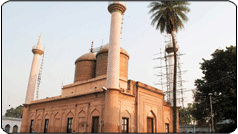Rauza Kazmain
The Nawabs of Awadh were Asna-e-Ashri Shia Muslims from Iran, who traced their lineage to seventh Imam Musa-al-Kazim. The Asna-e-Ashri Shias believe in the hereditary succession of twelve Imams as spiritual and religious heads appointed for their guidance and regard Hazrat Ali as the first Imam.
Strangely, it was not the Nawabs, but one of the converts, whose original name was Jagannath, who belonged to the family of Urai Lai Baqqal (grocer), who built the Rauza Kazmain in honour of Imam Musa Kazim. He was named Ghulam Raza Khan after his conversion and was bestowed the title of Sharaf-ud-Daulah [by King Amjad Ali Shah (1842-1847)]. However, according to a taaroekh (chronogram) composed for the completion of the shrine, it was completed in 1269 Hijri (1852), during the reign of King Wajid Ali Shah.
The shrine with two adjacent cylindrical domes, is in fact a replica of the original mausoleum at Kazmain in Iraq, where Imam Musa Kazim and Mohammed Taqui (the ninth Imam) lie buried. Their graves are adjacent to each other. The original tomb in Iraq has the domes and minarets covered with pure gold but the copy at Lucknow has domes covered with brass that was gold plated. There is one glaring difference in the two structures. At Lucknow, the cylidrical bodies of the domes have brick wall pattern over their surface while at Kazmain, the domes' surface are plain and their capping appears to be larger. Also, in the original shrine, the minarets are more ornate and beautiful.
The entry to Rauza Kazmain (at Lucknow) is through a large double-storeyed gateway and smaller gateways appear thereafter which lead to the ghulam gardish (quadrangle enclosed with small arched compartments) where the main Rauza is situated. The main hall of the Rauza has galleries on all four sides, one of which contains the graves of Sharaf-ud-Daulah and his wife. The graves are flushed with the level of the floor (and are not raised). A marble tablet over the grave of Sharaf-ud-Daulah has couplets in Persian praising him which culminate with a taareekh which provides his year of death as 1278 Hijri (1861).
Rauza Kazmain is one of the buildings that was ransacked and looted by British soldiers during March 1858 in the belief that the deposed King of Awadh, Wajid Ali Shah had buried the royal treasure somewhere in this shrine.
During the first ten days of the month of Muharrum, Taazias are placed in all the Imambaras and chowkies (temporary platforms) installed at different places in the city. On 10th of Muharrum (Ashra or Aashura), the day when the tragedy of Karbala had taken place, all these taazia are taken out in processions for burial at the Karbala grounds by a large number of Muslims and some Hindus as well. In anticipation of the huge demand for taazia for Muhurram. soon after the festival of Baqrid, a temporary make-shift handicraft industry for making Taazia is seen functioning around Rauza Kazmain where one will find a number of men, women and children engaged in the making of the various components with bamboo and glitz paper to form the taazia in different sizes.
Source:
Hindustan Times, City Scan, A Time in History
Wednesday 5.11.1997 — Rauza Kazmain: Silent sentinel of lost traditions

